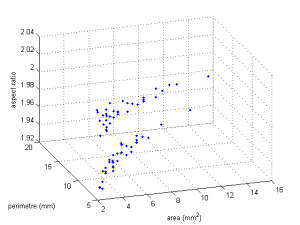
Introduction
In this post we repeat the ‘Experiment 02’ with the difference of generating high resolution images. We refer to high resolution as objects with a major axe about 136 pixels and a minor axe of 68 pixels (bigger ellipsoid in the image). We maintain the AR=2. We set scale with 136 pixels equivalent to 6 mm, simulating in this way a real rice kernel
Sample presentation & image capture
Image is generated with the same script that in the ‘Experiment 02′. We only change a0 and b0 values to 80 and 40 (maximum values in pixels for the ellipsoids’ semi-axes). Generated image is displayed on your left and objects’ information can be downloaded here.

Results
We use ImageJ to set threshold, segment objects and extract features. You can check the measurements in here. A number of 74 objects (excluding oin edges) are identified. Next, we run (this) Matlab’s script to load and display the data.
Discussion
Having a look on the results (scatter 3D plot) we can realize how objects could be easily clustered into two groups. This is in accordance with the original image where a manual inspection let’s us to check the (more or less clearly) two different sizes of rice kernels. If we represent are vs perimeter we observe the perfect correlation (0.99) between bot features. That is the best estimator to ensure that processing has been well done.
Conclusions
Image processing is a powerful tool for PSA and it is directly (and hardly) influenced by the image acquisition step. At this moment, the image resolution looks to be the most important handicap to overcome. On the other hand, the settings for the image’s resolution degree highlights an interesting way to research in a close future.